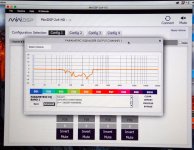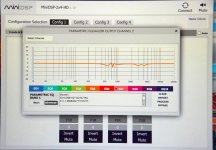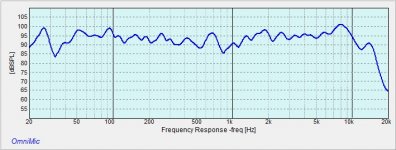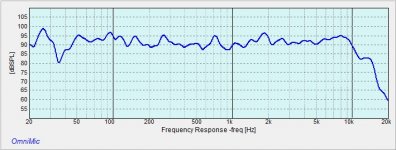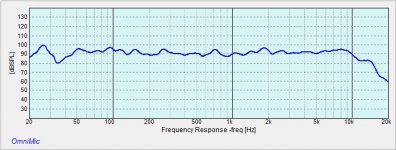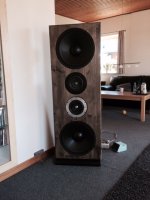Variac, what is your suggestion to remove the dip ? I move the speaker around the room, far and closer to the wall, still not improved the higher frequency. Of course, I have not made the measurement each time I moved the speaker around to see if the dip goes away or move to different frequency. I will make a few more measurement to see if the dip is still there at different angles of the mic to the speakers (which I think it still is since the frequency is still not "open and airy")
-Tom
-Tom
He says yes, and it’s not “open and airy” so seems to be the case. A 5k dip could do this
I think. I believe the SAL response is quite flat so that notch might be for anonter reason than the driver.. There is a frequency response curve for the driver around somewhere.
I don’t think the super tweeter is the answer to fix a notch But I do have speakers with a full range mid and a tweeter above 5k that work well. Kind off a shame to cut off a lot of the SALs response. Probably just adding complexity at this point-better to fix the response (somehow!)
yes, I did. If you looked back at the overlay plots. The BLUE curve is the Sub alone. I sweep it from 10hz to 500 hz
Not that I think this is related to the 5.5kHz dip, but looking at the sum of the SAL + woofers it does not look like the woofers are cut off at 300 Hz. Did you measure the response of the woofers alone?
Scottjoplin,
That is correct. I sweep each driver individually. The rest of the drivers are MUTED during the sweep.
That is correct. I sweep each driver individually. The rest of the drivers are MUTED during the sweep.
Are you putting the sweep through only the speaker under test?
Found:
Audio Dandy - How to enjoy High Resolution Audio
It’s actually in the pdf linked in the article
Audio Dandy - How to enjoy High Resolution Audio
It’s actually in the pdf linked in the article
Last edited:
Variac, what is your suggestion to remove the dip ? I move the speaker around the room, far and closer to the wall, still not improved the higher frequency. Of course, I have not made the measurement each time I moved the speaker around to see if the dip goes away or move to different frequency. I will make a few more measurement to see if the dip is still there at different angles of the mic to the speakers (which I think it still is since the frequency is still not "open and airy")
-Tom
To fix the dip you need to understand what causes the dip. That's why I suggested to take measurements at different angles and at different distances; and a time-domain measurement (impulse or step response) showing the direct sound from the driver and the later echoes etc.
Thanks mbrennwa, that's a very good idea. I will try it out as soon as I fix one of my amp channels! I don't think REW has a way for time-domain meas. All it does is to sweep SPL or Impedance from Start to Stop Freq with certain Level (dBFS) and length
Thanks for the input. I think this is the same as what mbrennwa suggested. If I move the mic at different angle, i will definitely get different response
Mr. Pass, thank you for chimming in with your inputs! How would you compensate for those dips especially at 5k ?
To fix the dip you need to understand what causes the dip. That's why I suggested to take measurements at different angles and at different distances; and a time-domain measurement (impulse or step response) showing the direct sound from the driver and the later echoes etc.
Thanks for the input. I think this is the same as what mbrennwa suggested. If I move the mic at different angle, i will definitely get different response
I think I read in an interview to Leonidas that moving the full range to the side of the baffle can change the sound.
Mr. Pass, thank you for chimming in with your inputs! How would you compensate for those dips especially at 5k ?
The SAL's that I play with consistently have a dip at 1K and 5K.
I don’t know, but I would try backing off the woofer volume more, just to see..plus it’s easy!
What experience I have with speakers has shown how greatly frequency response balance affects the entire impression of the speaker sound. Dips aren’t always that noticeable so we don’t want to get fixated on that necessarily being the problem...
What experience I have with speakers has shown how greatly frequency response balance affects the entire impression of the speaker sound. Dips aren’t always that noticeable so we don’t want to get fixated on that necessarily being the problem...
yes, I did. If you looked back at the overlay plots. The BLUE curve is the Sub alone. I sweep it from 10hz to 500 hz
That curve does not seem to show any effect of your claimed 300 Hz low pass. The output is at full level even at 500 Hz, where the measurement stopped. Please check again and take the measurement to a higher frequency. I suspect the woofer output is overlapping with the SAL quite a bit, which may affect the overall sound quality of your system.
I don't think REW has a way for time-domain meas. All it does is to sweep SPL or Impedance from Start to Stop Freq with certain Level (dBFS) and length
...and then it could use the sweep result to calculate the impulse response from the original test signal. That's the standard method to get the impulse response. A quick google search shows that REW can do impulse responses.
Thanks mbrennwa, that's a very good idea. I will try it out as soon as I fix one of my amp channels! I don't think REW has a way for time-domain meas. All it does is to sweep SPL or Impedance from Start to Stop Freq with certain Level (dBFS) and length
Thanks for the input. I think this is the same as what mbrennwa suggested. If I move the mic at different angle, i will definitely get different response
Mr. Pass, thank you for chimming in with your inputs! How would you compensate for those dips especially at 5k ?
Tom,
Ive sent a PM
This is what the EQ 'text' file turns into when imported into DSP PEQ
Channel 1 (SUB)
This is from a 400Hz xover point
Channel 2 SAL PEQ
All gobbledegook to me really but it sounds great...
Channel 1 (SUB)
This is from a 400Hz xover point
Channel 2 SAL PEQ
All gobbledegook to me really but it sounds great...
Attachments
Last edited:
How would you compensate for those dips especially at 5k ?
I don't do EQ except broadband. High Q equalization for narrow band
dips and peaks tends to defy correction. If you do want to try anyway, I
recommend going in half steps - if the peak/dip is 10 dB, then apply
5 dB correction and see how it goes.
In the end, your ear will be the most reliable judge.
I just took some quick measurements to see if I could replicate your results, but no matter what I did I couldn’t. I did manage to get a did at 800-900Hz at about 60cm from the full range unit. I use a singled ended triode amp. Hence the cutoff at high frequency.
Picture 1: 60cm resolution 5dB, Picture 2: 1M resolution 5dB, picture 3: 1M resolution 10 dB
Picture 1: 60cm resolution 5dB, Picture 2: 1M resolution 5dB, picture 3: 1M resolution 10 dB
Attachments
Last edited:
I just took some quick measurements to see if I could replicate your results, but no matter what I did I couldn’t. I did manage to get a did at 800-900Hz at about 60cm from the full range unit. I use a singled ended triode amp. Hence the cutoff at high frequency.
Picture 1: 60cm resolution 5dB, Picture 2: 1M resolution 5dB, picture 3: 1M resolution 10 dB
What is the acoustic environment with this (baffle width and driver position on baffle, box type, etc.)?
Frank, I believe you had the impulse and frequency response of the SAL driver measured by some external company. If so, can you provide these data?
Yeah, too much overlap at the mids can be horrible. That’s what I (probably poorly) said about frequency response variations. It’s a matter of getting balanced response. For example, too much mids or bass can make the treble sound too weak and poorly resolved. So in that case it is a mistake to start messing with the treble. Probably the last thing to do would be a super tweeter. That’s one more driver to make it even harder to get right, when there are other issues that are probably problems.
That curve does not seem to show any effect of your claimed 300 Hz low pass. The output is at full level even at 500 Hz, where the measurement stopped. Please check again and take the measurement to a higher frequency. I suspect the woofer output is overlapping with the SAL quite a bit, which may affect the overall sound quality of your system.
...and then it could use the sweep result to calculate the impulse response from the original test signal. That's the standard method to get the impulse response. A quick google search shows that REW can do impulse responses.
Last edited:
- Status
- This old topic is closed. If you want to reopen this topic, contact a moderator using the "Report Post" button.
- Home
- Loudspeakers
- Full Range
- SAL Full Range Drivers
